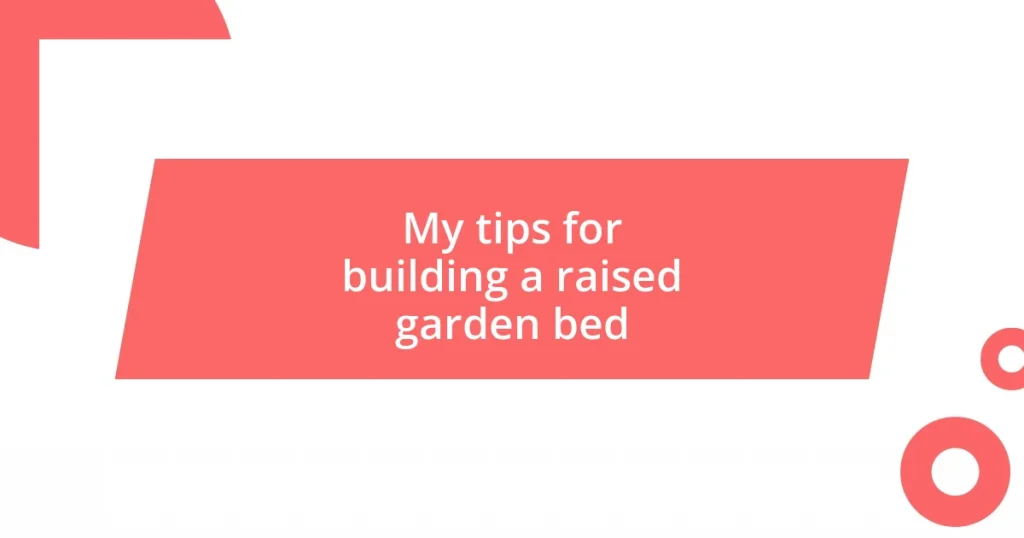Key takeaways:
- Choosing the right materials for raised garden beds, such as rot-resistant cedar or recycled bricks, is essential to ensure durability and safety for plants.
- Proper design considerations, including size, shape, and arrangement of plants, enhance both functionality and aesthetic appeal, optimizing sunlight access and growth.
- Regular maintenance, including moisture checks, weed management, and yearly soil replenishing, is crucial for sustaining a healthy and productive garden bed.
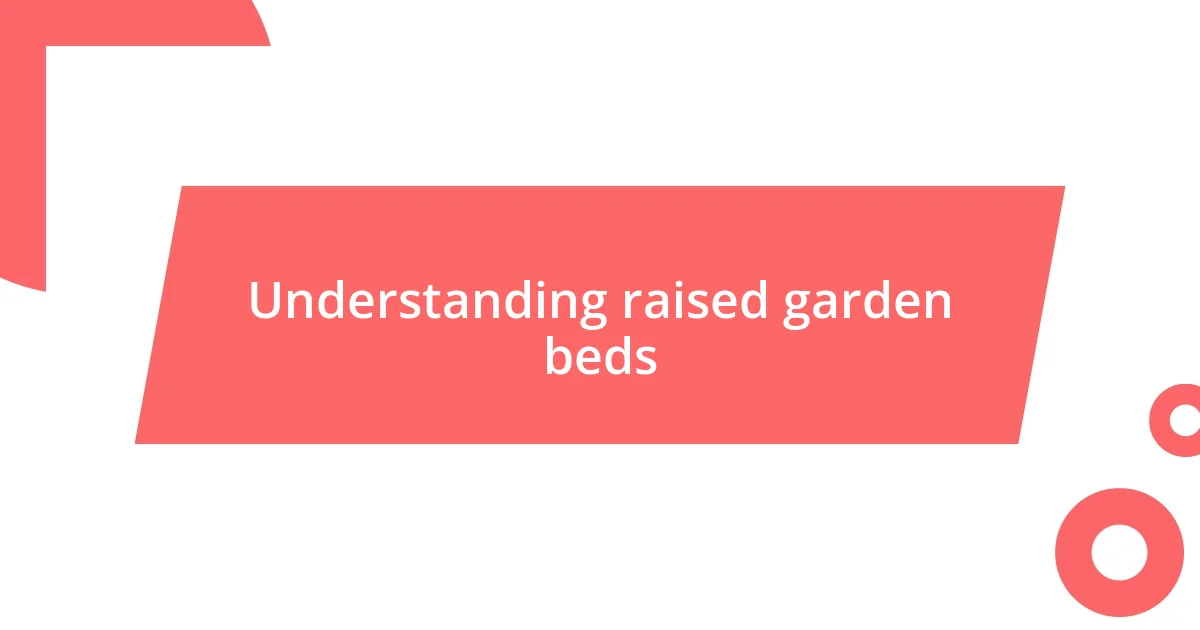
Understanding raised garden beds
Raised garden beds are an innovative way to grow plants while addressing common gardening challenges like poor soil drainage or pest control. I remember the first time I built one; it felt like creating my own tiny ecosystem, where I could control every element. The elevation not only makes gardening easier on your back but also provides better air circulation, which plants thrive on.
Have you ever struggled with weeds taking over your garden? I certainly have, but with raised beds, I found that those pesky weeds are much easier to manage. The height gives you a sense of ownership over the space, allowing you to introduce the soil quality that best suits your plants. Plus, the warmth of the soil in a raised bed can lead to an earlier planting season, which really makes you feel more in tune with nature.
Understanding the dimensions and depth of your raised garden bed is crucial for success. I learned the hard way that not all plants have the same root needs. For instance, deep-rooted veggies like carrots require a bed that’s at least 12 inches deep. Imagine the joy of harvesting a perfectly-sized carrot, knowing you set the right conditions all along!

Choosing the right materials
When it comes to choosing materials for your raised garden bed, consider both durability and safety for your plants. Personally, I’ve had success with cedar wood; it not only holds up well against rot but also naturally repels insects. The aroma of cedar brings back memories of my childhood, where I spent countless hours playing in my grandmother’s garden. It’s delightful to incorporate something that feels so nostalgic into my gardening practice.
Another option I’ve explored is using recycled materials, like old bricks or stones. These not only add a rustic charm to your garden but also provide excellent drainage. I once built a bed using leftover cinder blocks, which allowed me to create a unique, modular design. Each block became a canvas for my creativity, letting me experiment with different plant arrangements. Seeing the vibrant green leaves grow in a structure I constructed made each harvest special.
It’s essential to avoid materials treated with chemicals, as they can leach harmful substances into the soil. For instance, pressure-treated wood can contain arsenic, which could affect the plants you grow. I learned this by doing my research after my first attempt at building a bed with treated lumber. The look on my face when I discovered this was priceless, and I promptly changed my approach! Keeping your plants safe should always be at the forefront of your choices.
| Material | Pros | Cons |
|---|---|---|
| Cedar Wood | Rot-resistant, natural insect repellent | Higher cost |
| Recycled Bricks | Unique aesthetic, excellent drainage | Heavy and labor-intensive to move |
| Pressure-treated Wood | Inexpensive, durable | Treated with chemicals, not safe for edible plants |
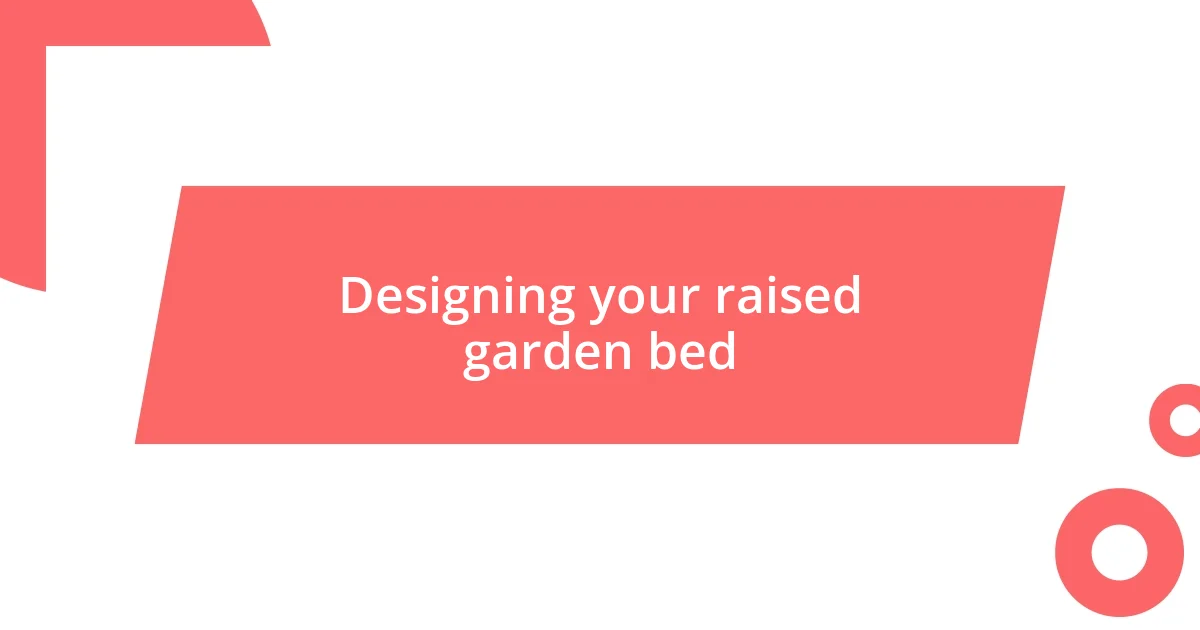
Designing your raised garden bed
Designing your raised garden bed involves careful consideration of size, shape, and functionality. Each design choice can enhance both the aesthetic appeal and the practicality of your garden. I remember the excitement of sketching my first layout, imagining the vibrant colors that would soon flourish. Creating curved beds not only adds a visually appealing aspect but also allows for easier access to all plants without stepping into the bed itself.
- Size: Aim for a width of 4 feet for easy reach from either side.
- Height: A 12-24 inch height provides optimal root depth and easier maintenance.
- Shape: Consider rectangular or square beds for a classic look; L-shaped or circular designs can offer a modern touch.
- Orientation: Position your beds for maximum sunlight, ideally north to south, to help plants receive even light throughout the day.
When I was planning my garden, I wanted every detail to be functional yet beautiful. Adding trellises into the design created a vertical garden aspect, which I found not only maximized space but also brought an unexpected burst of growth in my tomatoes. The rush of seeing flourishing plants climbing higher, reaching for the sun, was nothing short of magical. Each design element turned into an opportunity to experiment and witness nature’s wonders unfold in my own backyard.
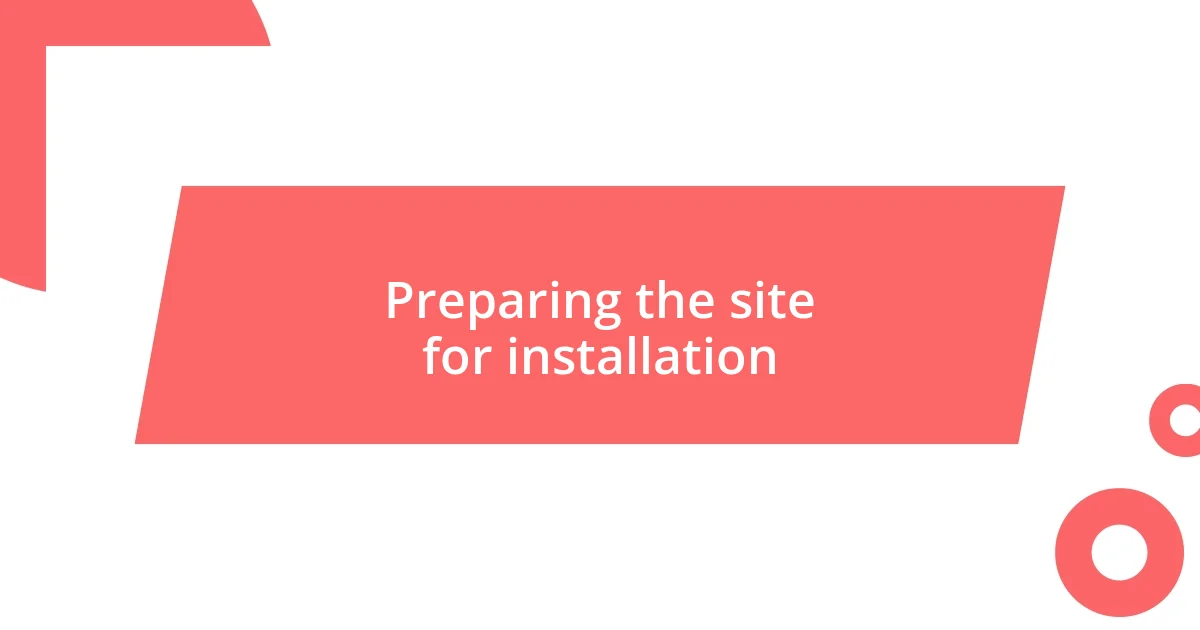
Preparing the site for installation
Finding the right spot for your raised garden bed is crucial. I’ve learned from experience that the location can make or break your gardening success. Look for an area that receives at least 6-8 hours of sunlight each day; otherwise, you might be disappointed with your harvest. Have you ever planted something in a shaded corner? I still remember the struggle of trying to coax a few limp tomatoes to life in such conditions—what a lesson that was!
Once you’ve found that sunny oasis, it’s time to clear the ground of any grass, weeds, or unwanted debris. I vividly recall the satisfaction of ripping out stubborn weeds from my chosen site; it was if I was clearing the path for my gardening dreams to take root. By removing these obstacles, you’re not just getting a fresh start; you’re ensuring that your plants can access the nutrients they need without competition.
Finally, leveling the ground is essential for even water distribution. I once neglected this step and ended up with a bed that pooled water dangerously after a rainstorm. That eye-opening experience taught me to always measure twice and dig once! Take a moment to run a rake over the area, and consider using stakes and string to outline where your bed will be. This simple act can make the entire process feel less daunting and more structured, guiding you as you embark on this exciting gardening journey.
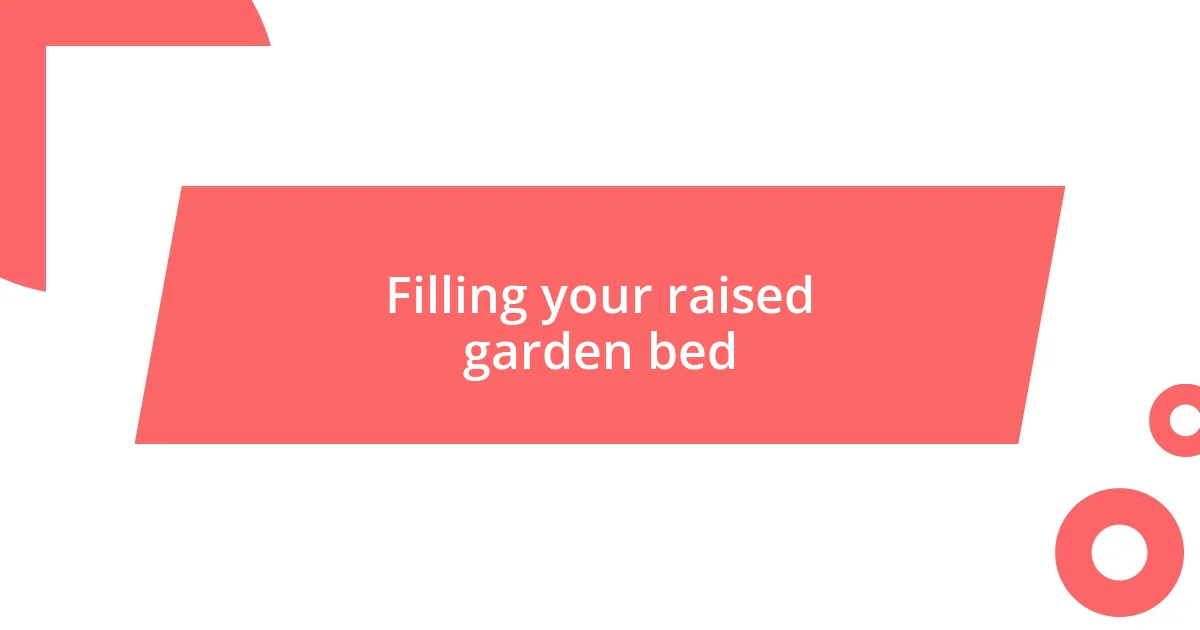
Filling your raised garden bed
When it comes to filling your raised garden bed, the right mix of materials can truly set the stage for your plants. I’ve experimented with different combinations, and I find that a blend of high-quality soil, compost, and organic matter creates the perfect foundation for vibrant growth. It’s like baking a cake—each ingredient plays a crucial role in the outcome, and you want to ensure that they are all fresh and nutritious. Have you ever tried starting with just plain dirt? I did, and let’s just say my plants were not impressed!
I usually start with a layer of coarse materials at the bottom, like twigs or straw, to promote drainage. Once, I tossed some old leaves in there, resulting in an unexpected burst of beneficial fungi. This innovative approach helped keep moisture levels balanced and aerated the soil. Right above that, I pile on a rich compost mix—a fabulous way to recycle kitchen scraps while pampering my plants with essential nutrients. It’s fulfilling to know that these tiny transformations contribute to the health of my garden.
Lastly, I top it off with nutrient-rich garden soil, making sure everything is well mixed. When you scoop up that first handful, there’s something magical about the dark, crumbly texture that tells you life is about to thrive in your raised bed. I remember my first harvest from such a bed; it felt like a celebration of all that nurturing and care. Just think about how your little green friends will flourish with this foundation! What plants are you imagining filling your garden?

Plant selection and arrangement
Selecting the right plants for your raised garden bed is an exciting part of the process. I often consider my local climate, as well as the space I have. For instance, I once tried to grow sprawling cucumbers in a small bed, and well, let’s just say they were more enthusiastic than I anticipated, overtaking my peppers! When planning, think about which vegetables or flowers not only thrive together but also appeal to you personally. What do you want to enjoy most from your garden—vibrant blooms or fresh, homegrown veggies?
Arrangement can make all the difference in how your plants grow. I’ve found that taller plants, such as tomatoes, work best at the back of the bed, while shorter ones, such as radishes, should go in front. This layered strategy ensures that each plant can soak up its fair share of sunlight without shadowing its neighbors. I vividly recall how frustrating it was when I didn’t consider height, and my basil was in mourning behind a towering sunflower. What works for you may take experimentation, but that’s part of the fun!
Don’t forget to think about companion planting! This method isn’t just a clever gardening trick; it can truly enhance growth and flavor. For example, I once planted carrots near onions, and it was like a delicious chemistry experiment—each plant benefited from the other’s presence. Have you ever wondered how such pairings could enhance your garden’s health? It’s fascinating to explore how specific combinations can deter pests while promoting more robust growth. Take a moment to plan your garden like a masterpiece, and watch the beauty unfold!
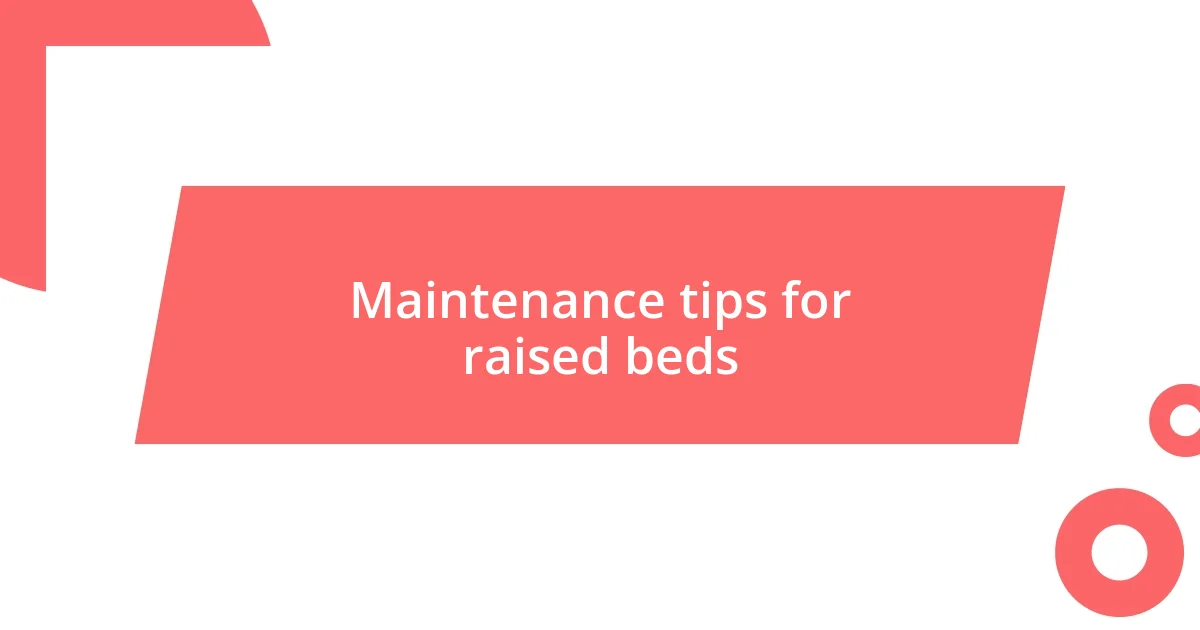
Maintenance tips for raised beds
Maintaining a raised garden bed is crucial for sustaining its health and productivity. From my experience, regularly checking moisture levels is a game-changer—too dry, and your plants might suffer; too wet, and you risk root rot. I’ve learned to stick my finger into the soil; if it’s dry an inch down, it’s time to water. How often have you overwatered your plants because they looked droopy? I certainly have!
Another tip is to keep an eye out for weeds. They can sneak into your bed faster than you’d believe! One summer, I let them take hold, thinking I’d tackle them later; by the time I got to it, they had turned into a tangled mess. Now, I spend a few minutes each week pulling out any newcomers, which makes a world of difference. It’s like tidying up your workspace—small efforts prevent chaos later.
Lastly, consider replenishing your soil mix yearly. I’ve noticed that plants thrive on fresh nutrients, and after each season, I add compost back into the mix. It’s amazing how a little bit of love can revive the soil. Have you thought about how a simple act of care can yield bountiful results? Observing my plants’ growth after a soil refresh feels rewarding—like giving them a well-deserved boost.










